How F1 teams run old race cars for rich owners and weekend grins
One week ago, California’s Weathertech Raceway Laguna Seca echoed with the howl of Formula 1 cars. Mario Andretti was there, and so was McLaren Racing CEO Zak Brown. Cars wore names like Ricciardo and Hamilton. A shipping container full of race tires had been flown in from England. Factory mechanics buzzed about, tending to various umbilicals and laptops.
And yet: This was not an F1 race. It was an annual motorsport celebration and vintage-racing event called Velocity Invitational. McLaren was there to demonstrate, among other things, four retired Formula 1 cars.
Those cars, listed by age:
- A 1985 MP4/2B driven by four-time world champion Alain Prost the year he won his first title
- A 1990 MP4/5 driven by three-time world champion Ayrton Senna the year he won his second title
- The 2012 MP4/27 in which seven-time F1 world champion Lewis Hamilton won his last race with McLaren
- A 2013 MP4/28 rewrapped in modern livery.
Those machines were lapped at speed every day. The 2012 car was driven by its owner, oil magnate Charles Nearburg. The other cars, McLaren property since new, were entrusted to friends of the company. Two-time F1 champion Mika Häkkinen, IndyCar phenom Pato O’Ward, and stunt driver Tanner Foust lapped the Senna and Prost tubs. The 82-year-old Andretti strapped into the MP4/28.
F1 cars are purpose-built weapons, immensely complex and high-strung. Like Ferrari, McLaren employs a small team of individuals to support its house collection of historic iron. This team also supports and assists with the exercise of the few McLaren Formula 1 cars in private hands.
To get a better idea of how all this works, we spoke with McLaren’s heritage-team manager, a former mechanic named Indy Lall. Lall, an industry legend, has worked for Woking’s motorsport arm since the 1980s. At Laguna, he was tired and fighting off a head cold but clearly in his element: surrounded by carbon-fiber and history and happier for it.
***

Sam Smith: Laptops. Shipping containers. This is not a small setup. What does it take to light these things off every day?
Indy Lall: Whether they’re historic cars or more modern ones, the preparation is exactly the same. It has to be thorough from front to back. Mechanically, electronically, hydraulically, you have to check everything over.
A more modern car, you’ll be looking at warming everything, warming the engine really carefully. It has to be a certain temperature before you’re even [physically] able to turn it over.
SS: The tolerances are that tight.
IL: It’s very complex. We have to go through all the systems checks to even think about firing up.
You can’t take this for granted. You can’t be underwhelmed by it. These are very, very special machines. They need a lot of care.

SS: I tested an Alonso chassis once, an MP4-22. It spent the night before plugged into an electrically heated fluid cart, warming. Three or four guys flew in from Mercedes to look after the engine alone.
The actual start was a key press on a laptop. If you didn’t know what you were watching, you might think these cars are easy to run.
IL: Once they’re older, it doesn’t mean the system’s changed to make them simpler.
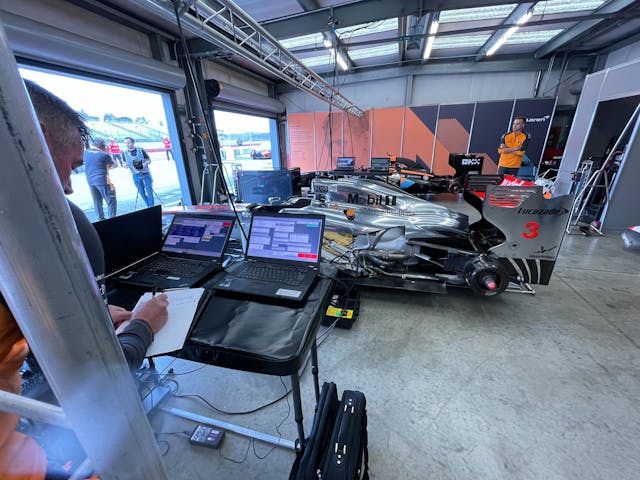
SS: F1 engines were once basically flash powder. The powertrains are now more durable, but rebuilds are still six figures. Now that the cars are no longer running competitively, do they get detuned, to help them last?
IL: We don’t detune anything, because they’ve been designed and manufactured to run at a certain spec. There’s too much to change if you try and detune them. Everything remains as it is, whether for a private customer or a two-time world champion like Mika Häkkinen.
There’s also … A private customer will never reach the limits the car was designed for. It has an inbuilt safety mechanism in that the driver will never drive it to those levels. That’s just fact.
SS: Some privately run F1 cars use lower rpm to help life. Seventeen thousand rpm instead of 18,000, that sort of thing.
IL: Yes, that would increase the lifespan. But the demonstrations that we’re doing here, they’re not super long. They’re not stressful.Sam Smith
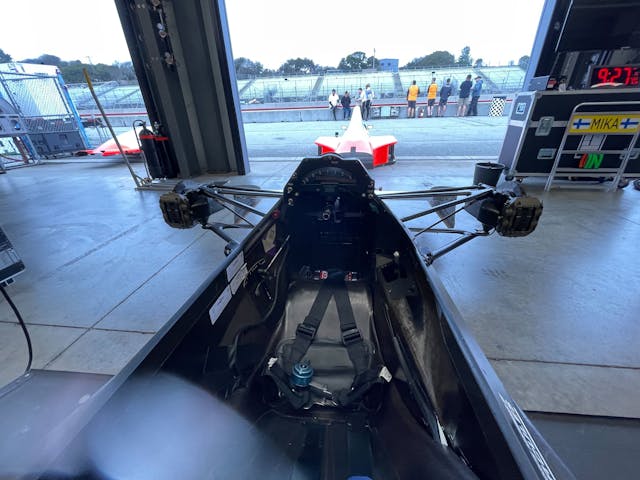
SS: Unlike Ferrari, McLaren hasn’t always sold old F1 cars to the public. How many customers do you now support?
IL: Obviously, compared to the Ferrari Clienti, our program is relatively young. Within our own small fold, I would say between six to eight customers at the moment, and it is growing. Obviously, the more enjoyment they get out of it, the more expressive they are, then it gets the attention of other people who own cars.
SS: That’s a small crowd, limited by number of cars in existence and the steep price of entry. Is it even possible to estimate the per-lap cost for something like this?
IL: It’d be very difficult to quantify. There’s no two cars the same [in history or spec], so the values are different. Depending on how much running a customer does, then obviously we have a living system to control how many miles or kilometers each component has done on any one car.
There are service intervals, and obviously, when reaching those service intervals, you get into servicing costs …
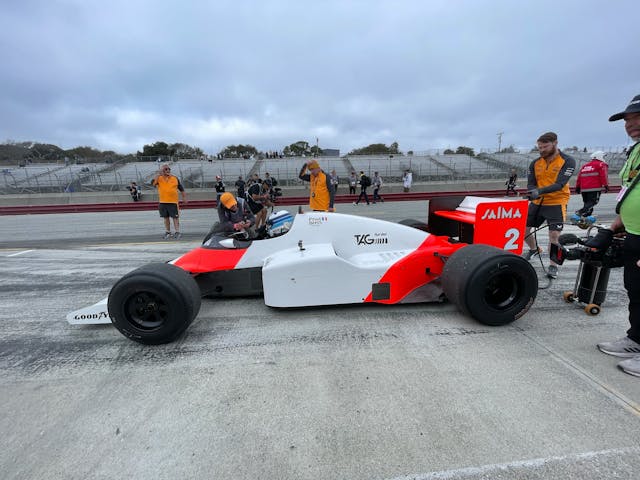
SS: The four machines here are from two vastly different eras. It’s kind of remarkable that the company can still hand-make every bit of each one. Because you did that originally, because that’s how F1 works.
IL: [Points to the Senna chassis] This car is completely original, as is the 2B. To a degree, we could remanufacture the engine on the 2B, which is the TAG [V-6] turbo. And you could also say that with the Honda [in the Senna chassis]. But they won’t be original post that.
Anything is possible. You can remanufacture anything, but you’ve got to have an original pattern first. You get to a stage where you’ve blown this engine, then you’ve lost your pattern.
SS: Component life has to vary hugely across generations, no?
IL: The modern ones, they’re very limited because they are pure racing engines. These [points to 1980s cars] were pure racing engines in the period, but relative to where things are nowadays, they’re quite strong.
Obviously, today in Formula 1, you’ve got to have three engines to last you 23 races, which is quite ludicrous. Say five years or seven years prior to that [practice], they were quite volatile. In those cases, the engines were genuinely one-race.

SS: How many people are required for support?
IL: The age of the car determines the level. A modern car, at minimum, you need to have systems guys from Mercedes and from McLaren. There’s three people. On top of that, you need three more mechanics to just start the car.
On average, you need six people per car, on a more modern car, and that’s bare minimum. An older car like this [points to Senna chassis], you could get away with three people. Just from a safety point of view, you need somebody at the front, controlling it; somebody starting it; and somebody taking care of the power supply.
SS: Assuming a car has been maintained well, what is prep time like?
IL: [The Senna and Prost cars are owned by] McLaren, coming from the U.K. We are able to maintain those, you could say, on a daily basis. We obviously know when they last ran. To prepare them to come out here was about four days per car.
Charlie Nearburg’s car, it’s based in Chicago. He last used it a year ago. That clearly needed some time spent on it, when we arrived here. It had the full attention of a complete crew, six people, for three days.
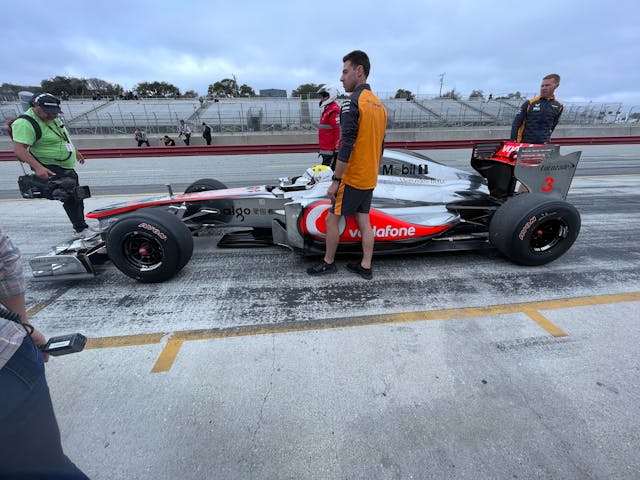
SS: You mentioned high limits. It can take a while for an owner to learn just what that means at the wheel. Are you set up to help them with that process?
IL: Depending on how engaged the owner wants to be. If he wants to learn, if he wants to progress—if he wants to understand what’s happening with the car? Then obviously, we’re here for those purposes.
SS: That test we did with the Alonso chassis incorporated car-to-car photography. The F1 car followed a new Corvette around the track at track-day pace, a photographer in the Chevy’s passenger seat. Even then, the McLaren kept getting hot, had to take breaks, it was going too slow.
That was just drivetrain temp. Working one of these things enough to get aero and brakes in the design window is something else entirely.
IL: One thing you do learn, a private customer is an intelligent individual—just to be able to purchase something of this value. But they will never take it to the limits. It will be impossible. In the instance of the [Lewis Hamilton car] here, that’s a blown diffuser car, Nearburg’s car.
A blown diffuser generates downforce in a corner, but he can’t bring it to that point. He will never, ever get [that diffuser working properly], because he’s of an age where he can’t [physically do] what the car requires for that. That is quite a tricky situation.
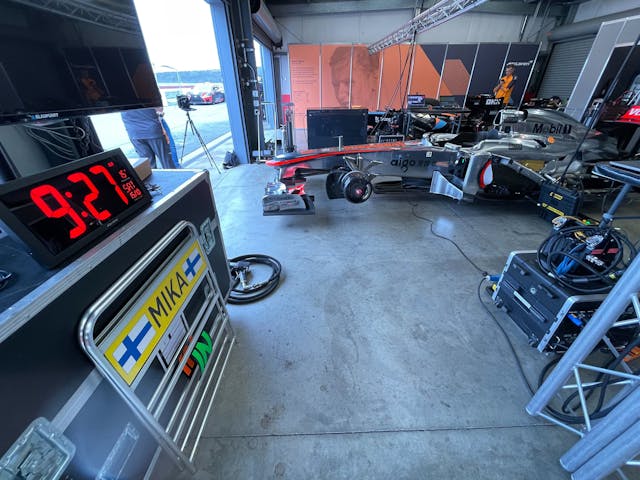
SS: Which isn’t a slight on Nearburg! Modern F1 cars see 4 or 5 g under braking, 6 g in corners, whatever it is now.
IL: Not at all! It’s just, as the cars get more modern, they become more complex. It’s very rare to start on a clean piece of paper. The cars are evolving, and naturally so are the engineers, the designers, and the young drivers coming along. They have a lot of input into the direction the car is going to go. They’re naturally growing with the progression.
All of a sudden, you put an older-generation individual into it, or anyone adding zero input … it’s very hard to comprehend the limits we need to push it to.
SS: Setup is critical with racing cars—not just for speed, but so the car feels right and is safe. Small changes in things like suspension or software can make a huge difference. How do you dial a car for a driver who isn’t an F1-grade athlete, who can’t contribute to that process in the same way?
IL: Well, first and foremost, you’ve got to make sure there’s sufficient grip and downforce to make it safe. Then you can build from there—to what their individual requirements are, what they’re feeling, how they want to tweak it.
We’re not a race team. We’ve got four very different cars here, very different eras. There’s only so much you can bring with you, or that actually exists, to devote time to each one.
It’s tricky. Fortunately, we’ve been here with Charlie before. We know the balance of the car, and he knows. However, if [an owner] wants to have a private day somewhere quietly, then you can put more input into it.

SS: It’s difficult to imagine getting used to that process.
IL: Well, every car is generally designed around a tire. In this case, we don’t use those tires any more. So it’s not 100 percent as it was designed to be. The tires are now good, high-grip demonstration tires. They naturally give any driver that confidence, the grip is there straightaway. That’s nice. In terms of how we tweak downforce or mechanical grip? We come here with the thought of not maximizing everything, but … let’s be in the ballpark. It gives us the latitude to go one way or the other, depending on how the driver feels, the conditions, and so forth.
With Charlie, he does give feedback. He’s a racer, he wants to improve. There’s something up there, though, that prevents [most people] from going over to that last little bit. In this instance, it’s that blown diffuser. We’ve done quite a bit of mechanical change and aero change for Charlie, to try and give him a more stable car in that [faster] part of the circuit.

SS: How does the car behave before the diffuser “wakes up,” as it were?
IL: Basically [if the diffuser isn’t in full effect], he’s got more front end than rear end. You tune it, try and balance aerodynamically more to the rear, to try and remove that sensitivity for him.

SS: You’ve been with McLaren for 35 years.
IL: I’ve seen a lot happen.
SS: Brief highlights?
IL: I ran Alain Prost in Formula 1.
SS: [gibbers]
IL: It was great to be world champions with him. When [McLaren chief] Ron [Dennis] signed the Honda deal the first time, I had the huge task of setting up testing, which was unique in those days. We would do, on average, 45 to 50 tests in a year between Europe and Japan. It was just constant. It was colossal.

SS: How did you get into motorsport?
IL: My father had two heavy-goods vehicle garages in Kenya, where I was born. While I was too young to understand it, it registered. Then, when we came to the U.K., my brother started racing Formula 4, and I thought, That’s cool.
Obviously couldn’t afford to go racing myself. I thought, “Well, I enjoy mechanicing,” so I pursued that.
SS: You started at McLaren?
IL: No, a very small family team, Mallock Racing. Building clubman cars.
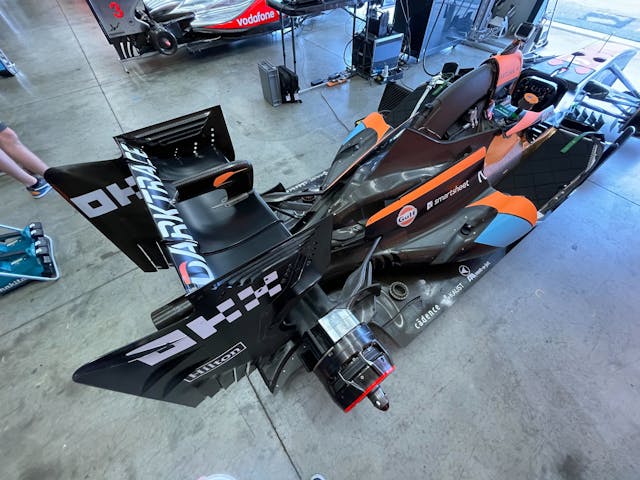
SS: You worked for Ray Mallock! Cool!
IL: Yes, Arthur Mallock and Ray Mallock. Ron was advertising for a project for Formula 3 mechanics. I went and saw Ron, only for him to tell me—he thought it was quite funny—that the job was actually gone.
I was a bit pissed. He said, “I can give you a job on the Formula 2 team,” and I said, “Okay. I’m not ready for it, but what is it?” He says, “It is a gopher.”
I didn’t know what a gopher was. “Well, go for this and go for that.”
He actually got quite sincere. He said, “Look, I’ll help you to reach your goals if you want to, but this is where everybody starts.” He explained that he wanted everything to be just 100 percent. I thought, “I don’t know whether your 100 percent is the same as mine, but let’s try and see if we can reach those goals.”
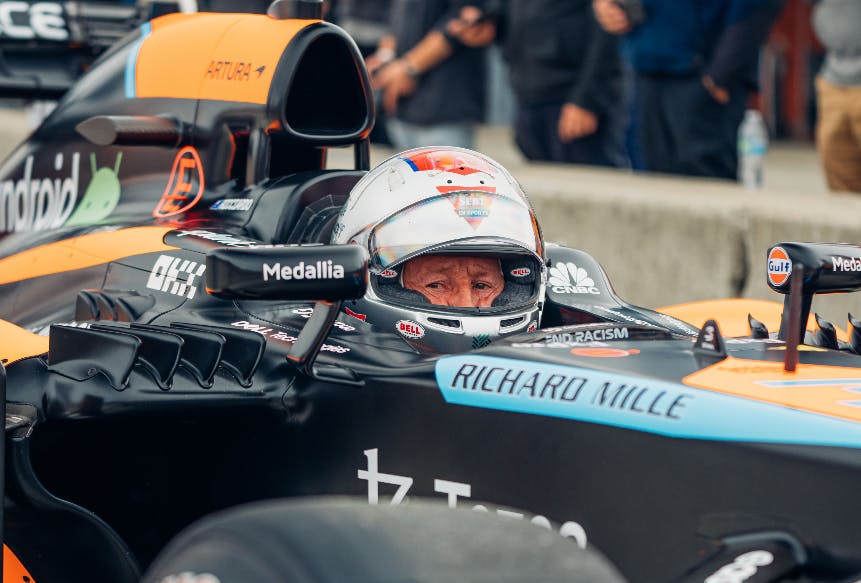
IL: I basically made it what it was. In terms of … I wanted to line everything up, I wanted everything polished. I sort of treated the mechanics that were above me as if … this is my home, and you’ve got to look after my home.
Everybody responded to it. And it just went up and up and up, and it set a level that others sort of tried to reach and emulate.
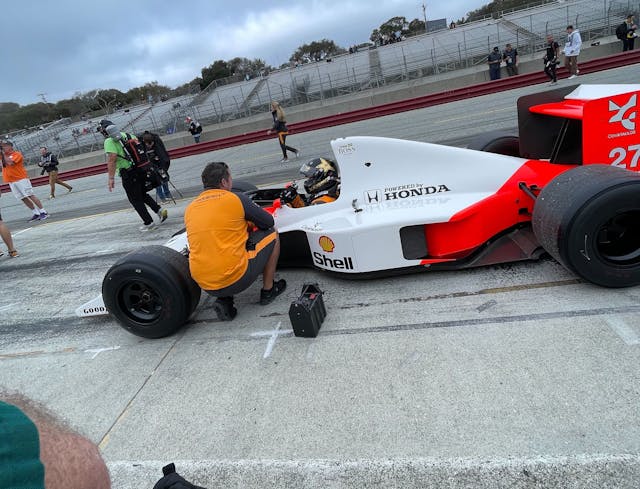
SS: That must have felt nice.
IL: The following year, I was mechanicing on the Formula 3 team. We won the British and European championships with Chico Serra. Then we went into Formula 2, which wasn’t so successful.
Ron got a contract to build the BMW M1 [supercar]. Which was super cool. He persuaded me, “You got to come.” Even though I felt I wasn’t ready for it. He said, “We’re in it together.” It’s been a long journey.
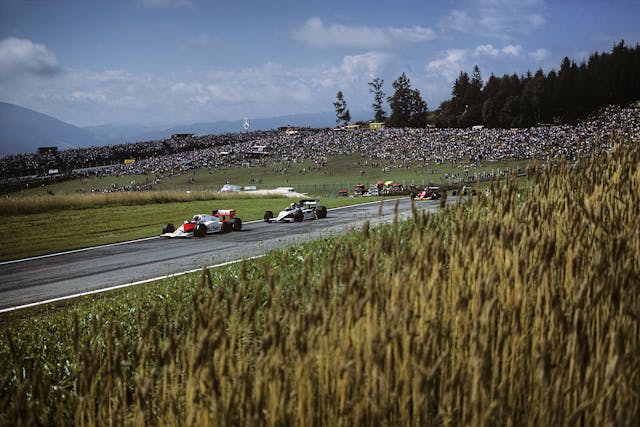
SS: Prost’s titles with McLaren, you were his chief mechanic, that would have been 1985 or 1986. What was that like? What did it teach you?
IL: What it … [Pauses, rubs eyes, takes a breath] What it was … like?
SS: Yes, if that’s alright?
IL: Excuse me, I …
SS: It’s okay if the answer is, It was a long time ago.
IL: No, it’s as clear as day. I only wanted to do … [Rubs eyes, voice cracks a little, pauses again]
SS: I’m … I’m so sorry to bother you while you’re sick. If you’d rather not … we can wrap this up.
IL: No, it’s that I wanted to make … I wanted to make one one phone call. When we won it, in Adelaide. [Wipes something from his eye] I’m sorry.

SS: I didn’t mean to upset you.
IL: [Another pause. Lall resumes speaking, his voice cracking] I wanted to call my father … to show him what we had achieved. He didn’t want me to go into mechanicing because he obviously had a family, and his hands were black. He thought it was going to be the same.
We won the championship, but I couldn’t call him because he passed away.
SS: I’m so sorry.
IL: You do go with emotion. Sorry, man. [Rubs eyes]
SS: It must have meant so much. I wouldn’t have asked if …
IL: No, you want to know. I didn’t figure it out that fast. After so many years … it’s not something I talk about.

SS: I cannot . . . It must have been . . . Was it difficult, saying goodbye to that part of the sport? Leaving an active F1 team after those heights?
IL: No. I enjoyed it, then. The team was smaller because the complexity wasn’t there, as it is now. There was more camaraderie.
Now, the opportunity is similar to when I was running the test team. Bringing young mechanics on and young engineers on, passing the knowledge onto them. It’s very much the same now, and that’s doubly fulfilling.
***
This interview has been edited and condensed.
Check out the Hagerty Media homepage so you don’t miss a single story, or better yet, bookmark it.



I never would have thought those cars needed that much attention. Interesting – but it seems like you would have to have an abundance of cash and the exact opposite in brain cells to want to buy something like that used